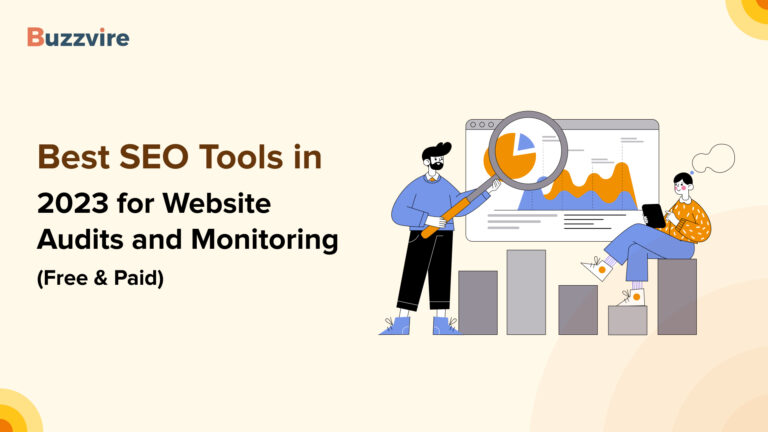In the ever-evolving digital landscape, implementing effective and correct search engine optimization (SEO) practices is imperative to stay ahead of the curve. While SEO is a vast field with a huge scope, employing long-tail keywords is a prominent aspect that has gained significant importance recently. Long-tail keywords present many advantages and boost the SEO strategy, allowing you to target specific audiences and drive high-quality traffic to your website.

In this blog, we will dive into the intricacies of long-tail keywords, understand their benefits, and expand on how to seamlessly integrate them into your SEO strategy to gain maximum benefit.
Understanding Long-Tail Keywords
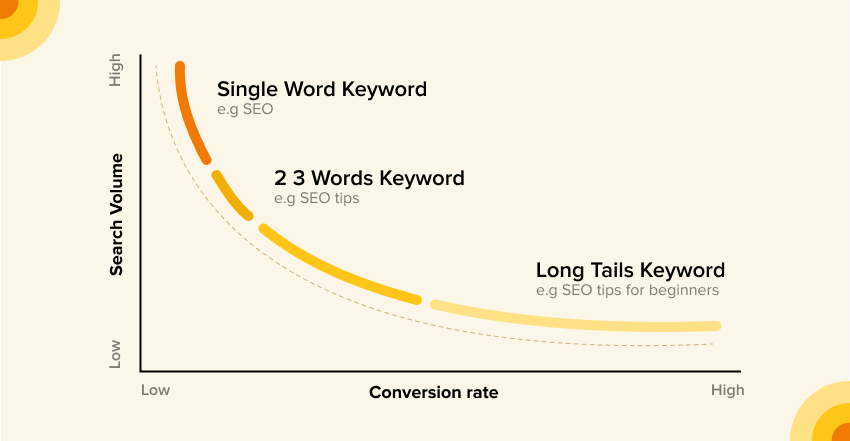
Long-tail keywords are specific search terms comprising three or more words. These have low search volume and precisely target people seeking specialized information. Now, the question is, how do long-tail keywords help better SEO strategy despite low search volume? Using long-tail keywords for local SEO practices enables targeting a precise and genuine audience. Low search volume also means less competition but higher chances of conversions. Long tail keywords empower businesses to concentrate their efforts on niche markets and connect with users who have progressed further along the purchasing journey, thus amplifying conversion rates.
Short-Tail vs. Long-Tail Keywords: Which is Better for SEO?
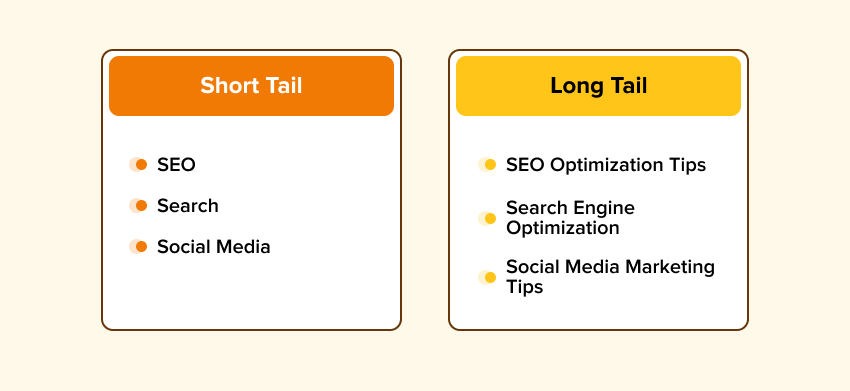
| Short-Tail Keywords | Long-Tail Keywords | |
| Length | Usually one or two words | Consist of three or more words |
| Specificity | Broad and general | Highly specific and targeted |
| Search Volume | Higher search volume | Lower search volume |
| Competition | More competitive | Less competitive |
| User Intent | Often used for general queries or research purposes | Reflects specific user intent and information needs |
| Conversion Potential | Lower conversion potential due to broadness | Higher conversion potential due to specificity |
| Ranking Difficulty | Harder to rank for in search engine results | Easier to rank for in search engine results |
| Target Audience | Targets a broader audience | Targets a specific niche or audience segment |
| Cost and Bid | Higher cost and bidding competition in paid advertising | Lower cost and bidding competition in paid advertising |
| Traffic Quality | Can attract a mix of relevant and irrelevant traffic | Attracts more qualified and targeted traffic |
| Content Optimization | Requires broader content to cover a wider range of topics | Can be used to create highly relevant and specific content |
The primary distinction between long-tail and short-tail keywords is their specificity and search volume. However, short-tail keywords may boast higher search volumes but face fierce competition. Consequently, ranking for short-tail keywords can take time and effort. However, long-tail keywords possess lower search volumes but encounter less competition. Ergo, by concentrating on long-tail keywords, the probability of securing a favorable ranking escalates, thus attracting more relevant traffic to your website.
Benefits of Long-Tail Keywords
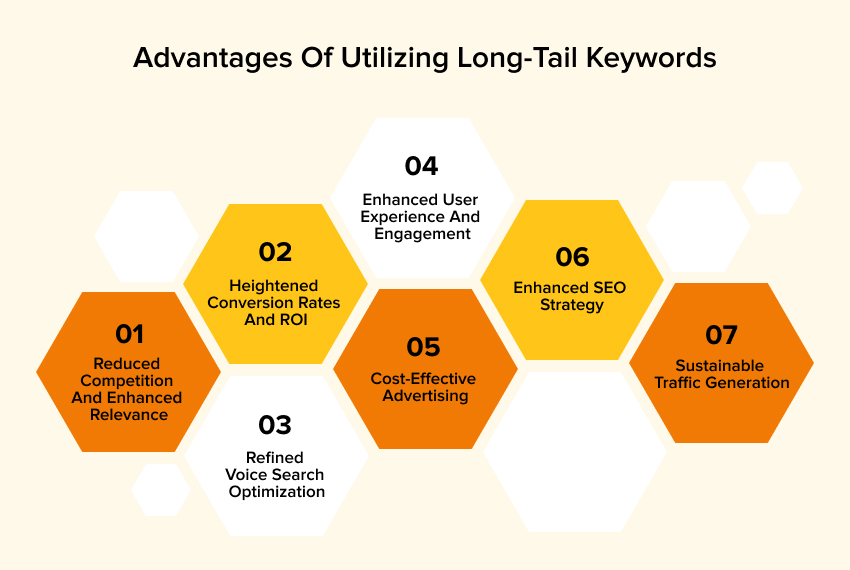
Reduced Competition and Enhanced Relevance
As mentioned earlier, long-tail keywords face less competition in comparison to their short-tail counterparts. You can tap into niche markets and target exceedingly relevant audiences by directing your focus toward these particular phrases. The enhanced relevance translates into higher click-through rates (CTR) and augmented conversion rates.
Heightened Conversion Rates and Return on Investment (ROI)
Long-tail keywords have earned a reputation for generating superior conversion rates. Given that they directly mirror users’ intentions, they attract visitors more inclined to express interest in your products or services. By catering to these specific needs, you can offer relevant solutions and improve the likelihood of converting visitors into customers. Furthermore, long-tail keywords often face lesser competition, which implies that investing in their optimization can yield a more substantial return on investment (ROI).
Enhanced User Experience and Engagement
Users searching for precise long-tail keywords expect to unearth accurate information or solutions. By optimizing your content to align with these keywords, you can provide an enhanced user experience precisely by delivering what they seek. Consequently, this promotes superior engagement metrics, including long time spent on the page, diminished bounce rates, and an upsurge in page views. Search engines also consider user experience signals when ranking websites, thereby implying that optimizing for long-tail keywords can tangentially improve your search engine rankings.
Refined Voice Search Optimization
The rapidly evolving prevalence of voice search has revolutionized the manner in which individuals interact with search engines. Voice searches adopt a more conversational and protracted format. Thus, the role of long-tail keywords in voice search optimization is essential to attract relevant audiences. Consider optimizing your website for voice searches to augment your visibility within this rapidly expanding search medium by incorporating these specific phrases into your content.
Cost-Effective Advertising
When it comes to economic promotion, using long-tail keywords presents a prudent option for businesses, especially those with limited advertising budgets. In contrast with short-term keywords, long-tail keywords exhibit lower competition and cost per click in paid advertising. This characteristic allows businesses to allocate their financial resources astutely, as they can target long-tail keywords to access a more precisely defined audience without excessive expenditures. By emphasizing utilizing long-tail keywords, businesses can optimize their advertising campaigns to attract the ideal audience and yield a higher ROI (Return on Investment).
Enhanced SEO Strategy
“What are long-tail keywords and why they matter for SEO?” is one of the most talked about questions among SEO experts. By integrating long-tail keywords into the SEO approach, businesses can reap an array of benefits by diversifying their keyword portfolio and attracting wider traffic organically. By strategically targeting a combination of concise keywords, businesses can craft a comprehensive SEO strategy that encompasses both overarching themes and precise inquiries. This approach enables them to cater to the diverse requirements of their audience, increase the chances of securing higher rankings in search engine results, and attract organic traffic from diverse sources. Moreover, optimizing content with long-tail keywords elevates the overall relevance of the website, positively increasing its visibility and authority.
Sustainable Traffic Generation
Long-tail keywords assume a paramount role in generating consistent traffic over extended periods. While individual long-tail keywords may not exhibit substantial search volumes, their collective impact can contribute significantly to the organic traffic garnered by a website. As these keywords target precisely to users with specific requirements, they attract visitors with a higher possibility of engagement, repeated website visits, and eventual conversion into loyal customers.
How to Effectively Use Long-Tail Keywords in Your SEO Strategy

Now that we have elucidated the advantages of long-tail keywords, let us understand how to integrate them into your SEO strategy effectively.
Keyword Research and Analysis
Initiate the process by identifying long-tail keywords that align with your business and target audience. Consider leveraging keyword research tools such as Google Keyword Planner, SEMrush, or Moz Keyword Explorer to unearth potential long-tail keywords. Analyze each keyword’s search volume and competition to determine their value and alignment with your objectives.
To identify the long-tail keywords you can use the Keyword magic tool of SEMRush.
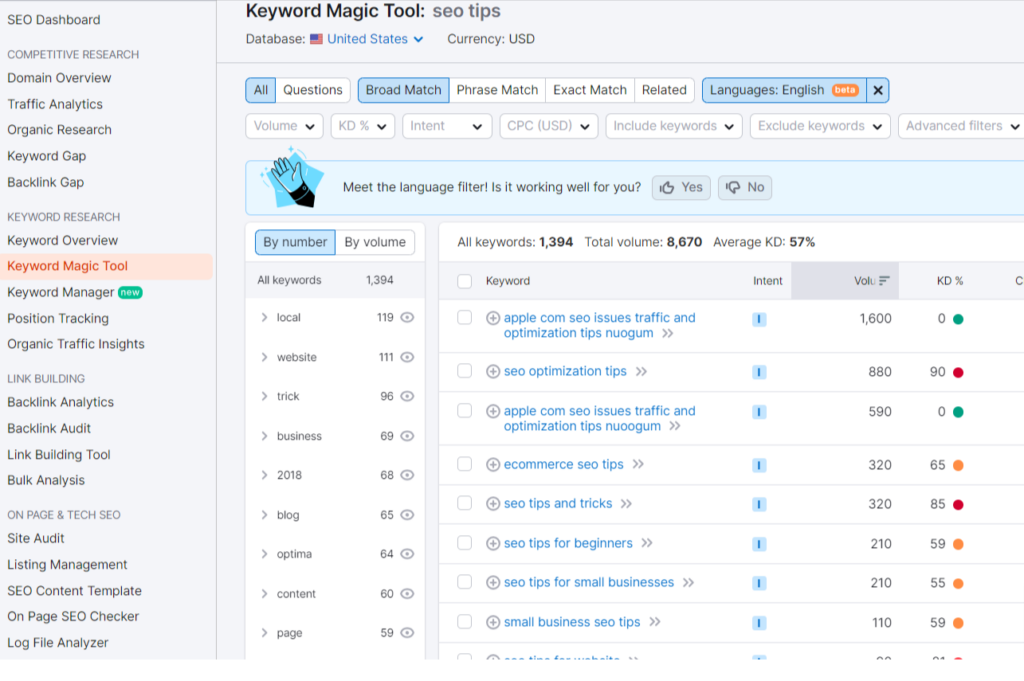
Try Google Search Features
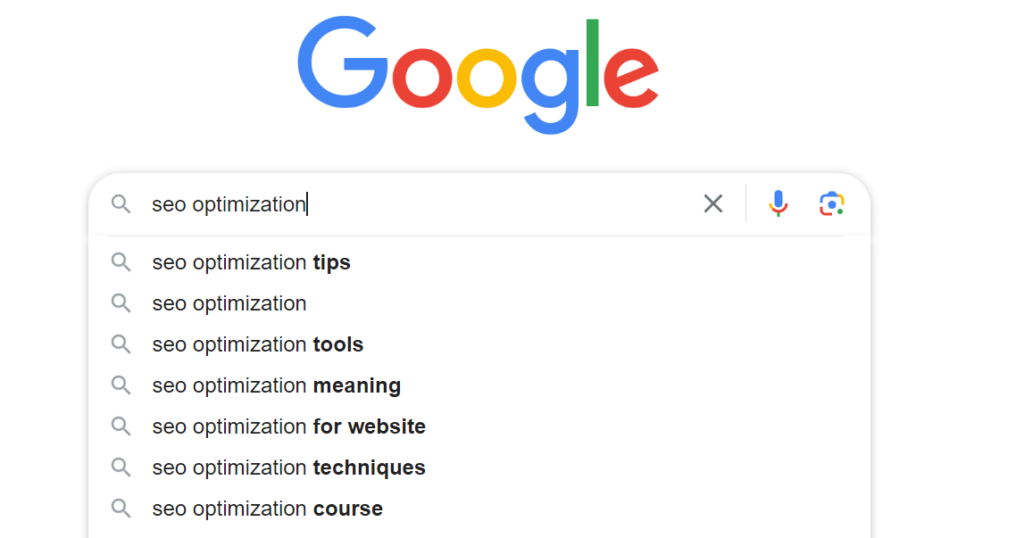
On-Page Optimization
Once you have identified your target long-tail keywords, it is imperative to incorporate them into your content seamlessly. Steer clear of excessive keyword repetition, as it can detrimentally impact user experience and search engine rankings. Instead, prioritize creating high-quality, informative content that integrates your long-tail keywords effortlessly. Furthermore, optimize your on-page SEO elements like page titles, meta descriptions, and headers to encompass these keywords, signaling your content’s relevance to search engines.
Off-Page Optimization
Establishing high-quality backlinks constitutes a pivotal aspect of SEO. When capitalizing on long-tail keywords, consider employing them as anchor text when acquiring backlinks from reputable websites. This approach bolsters the relevance and authority of your content in the eyes of search engines.
Tracking and Analyzing Results
To ascertain the efficacy of your long-tail keyword strategy, vigilantly track and analyze the results. Monitor the traffic and engagement metrics associated with each long-tail keyword to identify those that yield favorable outcomes. Based on the performance data, make required adjustments to your strategy to perpetually optimize your results.
Best Practices for Long-Tail Keyword SEO
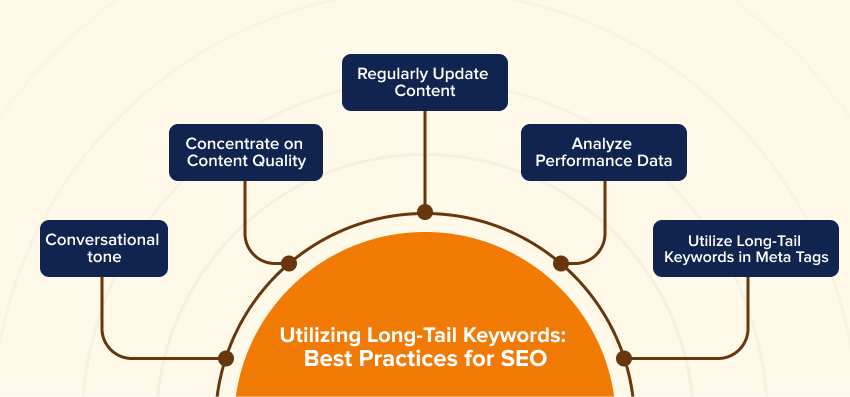
Adopting the following best practices can optimize the advantages conferred by long-tail keywords in your SEO strategy:
Conversational tone
When assimilating long-tail keywords, it is imperative to integrate them seamlessly into your content using a conversational and natural tone. Long-tail keywords are often complete phrases users use while seeking information. By developing content that directly caters to these particular user needs and queries, you can elevate its relevance and enhance the user experience. However, ensure that you avoid awkward keyword placement and integrate long-tail keywords naturally in your content.
Concentrate on Content Quality
While optimizing for long-tail keywords, prioritizing quality content is paramount. Users appreciate informative, captivating, and valuable content that satiates their requirements. Therefore, ensure that your content comprehensively covers the topic at hand and provides extensive insights. By creating valuable content, you can establish your website as a trustworthy source of information and amplify user satisfaction. Moreover, quality content will likely attract more backlinks and social shares, increasing your search engine rankings.
Regularly Update Content
Long-tail keyword optimization should be continuous. Continuously updating your content to incorporate fresh long-tail keywords that align with evolving search trends and the market’s ever-changing demands. When you optimize and update your content, you improve its visibility on the search engine results page. And it will undoubtedly bring more visitors to your site over time. Remain well-informed about industry trends and user preferences, and adapt your content strategy accordingly to remain pertinent and continuously attract traffic.
Analyze Performance Data
Remember, within a specific time frame, it’s wise to analyze your performance data to understand how effectively your current strategy functions for the brand. And the same goes for long-tail keyword optimization practice. Tools such as Google Analytics, Semrush, and Search Console data can help you assess keyword rankings, organic traffic, bounce rates, and conversions. Discern patterns, trends, and areas that require improvement. This data lets you plan out the most effective SEO strategy to help your brand skyrocket among its competitors and maximize the ROI.
Utilize Long-Tail Keywords in Meta Tags
Integrating long-tail keywords into meta tags, such as meta titles and descriptions, can amplify your website’s visibility in search engine results pages. So, using these keywords in your meta and header tags is highly recommended. This technique ensures that search engines show your content snippets to readers, improving your page’s CTRs (click-through rates) and attracting the target demographic.
Conclusion
Integrating long-tail keywords into your SEO strategy accords numerous benefits. By targeting specific user intent, you can attract more relevant traffic, boost conversion rates, and enhance user experience. By conducting meticulous keyword research, optimizing your content, and diligently monitoring performance, you can maximize the power of long-tail keywords and propel your website toward greater visibility and success in the digital sphere.
FAQs
Keywords that consist of three or more words are considered long-tail keywords, whereas short-tail keywords are of one or two words. Long-tail keywords have a lower search volume but a more focused and targeted audience. Thus, the chances of conversion rise. Short-tail keywords, on the other hand, have a higher search volume and target a general audience. Higher search volume attracts more competitors increasing CTR (Click through rates) and raising your online marketing expenses.
Long-tail keywords are long phrases or a combination of phrases. People who are looking for a direct and particular solution use them. These people are halfway through their purchasing decision, increasing the chances of conversion. Additionally, since the long-tail keywords have low search volume, their CPC (Cost-per-Click) is also less, reducing your online advertising cost. You basically get a specified audience with less CPC.
Finding the right long-tail keywords starts with understanding your audience and their intent. Then, proceed by conducting keyword research using reliable keyword analyzing tools like Google Keyword Planner, SEMrush, etc. You can use social media platforms, forums, or user search queries to identify relevant phrases and questions to start your long-tail keyword research.
Of course, you can use long-tail keywords for your paid search campaigns. Doing so will give you more valuable leads as people looking for a particular solution use longer search phrases. It will also cut your advertising costs because long-tail keywords have low search volume. Thus, by using long-tail keywords in your paid search campaigns, you can significantly cut your marketing cost while generating serious and valuable leads.
If you are wondering how to find and use long-tail keywords in your content, the number of keywords in a content piece depends on various factors, such as length, purpose, and intent. On average, keywords should comprise about 0.5 to 1 percent of your total word count. However, your focus should be on developing high-quality and relevant content.


